Mauricio Pochettino brings his signature tactical style to the United States, offering a fascinating blend of structure and fluidity. Known for his emphasis on pressing, positional play, and team cohesion, Pochettino’s methods are shaping an intriguing footballing identity. This analysis dives into his tactical framework, exploring how he balances defensive organization with attacking creativity to influence his team’s performance.
Build-up
Low Build-up
In the low build-up, Mauricio Pochettino usually sets his team up in either a 1-4-2-3-1 formation;




Pochettino mainly wants his team to beat the press by finding an attacking midfielder in the space between the opposition’s defense and midfield, who can bounce the ball to a holding midfielder, who then can progress the ball forward. When USA beat the press, the attackers will immediately make runs in behind, looking to exploit the space behind the opposition’s backline.
Pochettino’s players are also not afraid to be more direct in the low build-up. If the opposition comes up and presses man-to-man, there will be numerical equality up top with USA’s attackers against the opposition defenders. The goalkeeper will sometimes find an early longer ball up to the attackers, aiming to win 4v4 or 3v3 situations. The USA attackers have good individual quality and will often win these battles to create goalscoring
High Build-up
In the high build-up, Pochettino wants his team to rotate into a 1-3-2-5 formation.
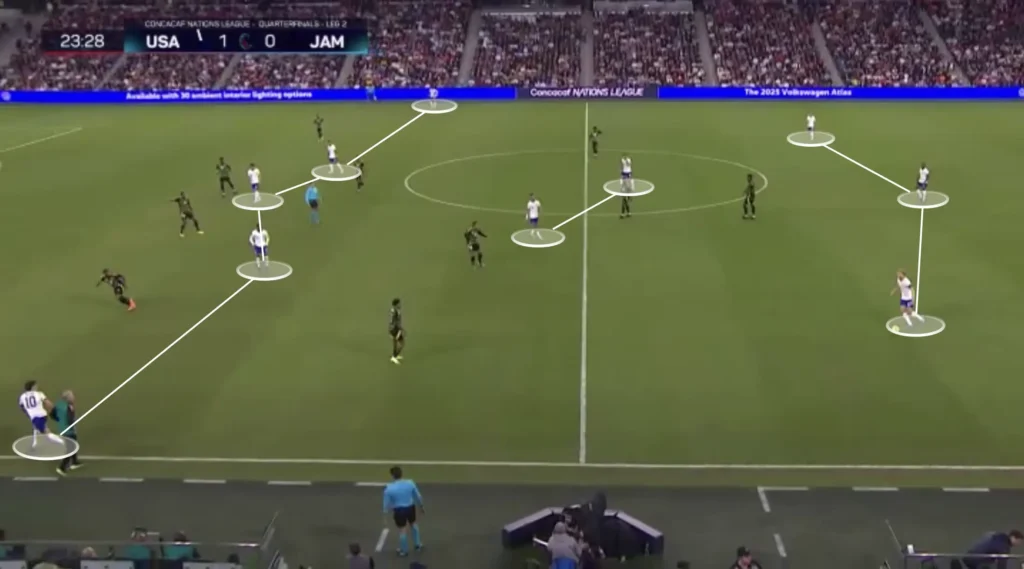
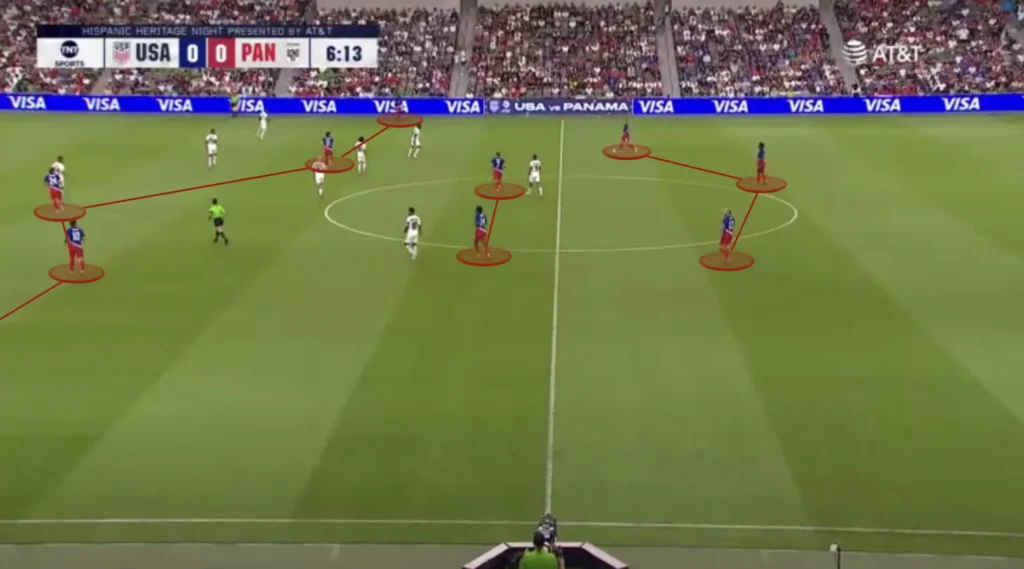
They can do this in different ways depending on what structure they are using in the low build-up.
If they initially build up in the 1-4-2-3-1 formation, the left-winger, Christian Pulisic, will come into the midfield, the left-back, Antonee Robinson, will push up as a left-winger, and the right-back, Joe Scally, will come in next to the center-backs.

However, when they use the 1-4-3-3 formation in the low build-up, Scally still comes in next to the center-backs, while Robinson inverts into the middle instead of pushing up on the wing.

Staggered Midfield
Pochettino usually wants the two holding midfielders to be in different lines during the build-up. This is crucial for creating passing lanes and disrupting the opposition’s defensive structure.

When the holding midfielders are staggered—one slightly ahead of the other—it forces the opposition’s attackers to make difficult decisions on who to block off, opening up space for the team to advance the ball. This layered positioning also enhances ball circulation by providing multiple angles for passing, reducing the risk of predictable or intercepted passes. The holding midfielders can play between themselves, allowing them to find third-man combinations to beat the opposition’s first line of pressure.
Rotations and Fluidity
The USA players constantly rotate during the build-up. The team adopts a dynamic approach, shifting between formations to create numerical advantages and exploit spaces. Pochettino’s focus is always to get the players into their best positions, where they can make the most out of their individual skills. He emphasizes versatility, with players interchanging positions seamlessly to maintain possession and disrupt the opposition’s defensive structure. This flexibility creates numerical superiorities in different areas, allowing USA to bypass the opposition’s press while maintaining control.
One of the center-backs will, for example, often move up into the midfield, creating a 1-2-3-5 formation. This rotation gives Pochettino’s team more players higher up the pitch and can help break down teams who defend deep in a low-block.

Numerical Advantages in the Middle
Regardless of the structure, USA will have many players in the center. Pochettino usually has a winger wide on each side and positions the remaining eight players in the middle.
Having only the two wingers out wide and the rest in the middle creates more options in the center and less space between the players. Pochettino likes this because he prioritizes playing through the middle. He needs one player out wide to pull the opposition apart while the rest create numerical advantages in the midfield areas.
When a team outnumbers the opposition in the midfield, it can more easily retain the ball, exploit spaces, and progress the ball through the center. USA will often progress the ball through quick central passes between the midfielders, beating the opposition’s press and exploiting gaps in the defense.
Another purpose for keeping many players in the middle is to shorten the distance between them. This shortens the length of the passes, which naturally shortens the time between passes. This means the opposition players will have less time to push up and press, giving the USA players more time and control.
Rest-Defence
Pochettino also wants many players close to the center to create a good rest-defence structure. Rest-defence in football refers to a team’s defensive organization and structure when they have possession of the ball, specifically aimed at being prepared to defend immediately if they lose it. A good rest-defence structure is crucial for maintaining balance and preventing counterattacks when the team is in possession.
Having many players in the middle and close to the ball gives USA a good rest-defence, since it allows more players to counterpress when they lose the ball. When losing possession, the four or five USA players closest will immediately jump on the opposition player with the ball and close the distance to cut off any passing lanes. This approach disrupts the opponent’s transition from defense to attack, forcing errors and creating opportunities to regain control of the ball.
Counterpressing like this keeps Pochettino’s team on the front foot, allowing them to dominate possession and create more scoring opportunities. However, it requires exceptional fitness, tactical discipline, and teamwork.
Finding the Pockets
Pochettino’s players always try to find the attacking midfielders in the pockets. These “pockets” refer to the spaces between the opposition’s defensive and midfield lines, where the attacking midfielders can receive the ball in more advanced positions.

By positioning themselves intelligently in these pockets, the attacking midfielders can turn quickly and face the opposition’s goal, creating opportunities for through balls, driving runs, or direct shots. This positioning forces the opposition to make difficult decisions. If an opposition defender steps up and closes down the attacking midfielder, he potentially leaves space behind. However, if he stays back, he allows the attacking midfielder time on the ball. The USA defenders and holding midfielders will often look for straight or diagonal passes, breaking the opposition lines and finding the attacking midfielders who can turn and drive at the defense.
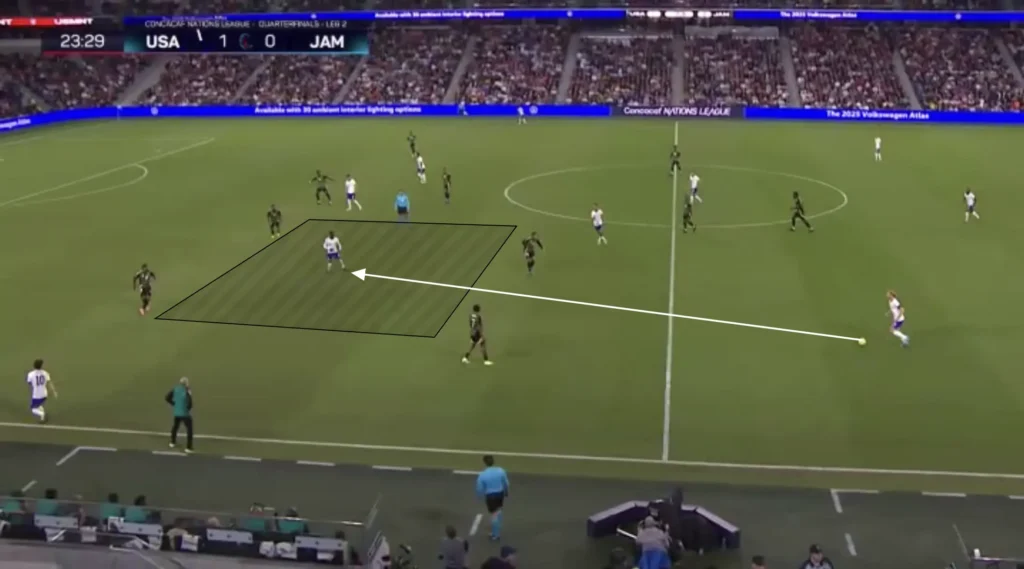
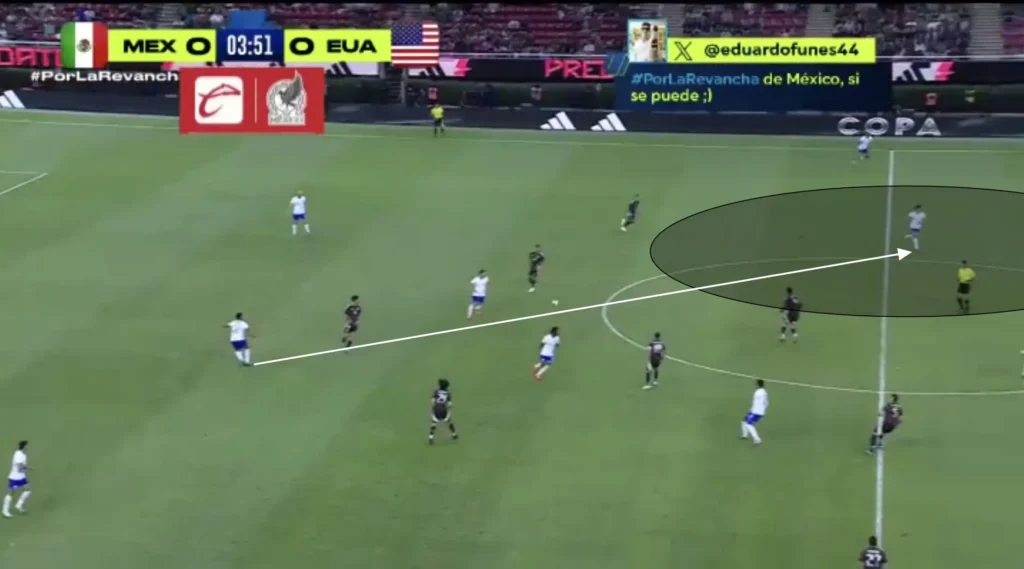
Finding these pockets is crucial for maintaining fluidity in attack and ensuring that the team can progress the ball effectively through the middle of the pitch.
Dropping Outside
When the opposition defends very compactly and does not allow the attacking midfielders to be found in the pockets, USA’s attacking midfielders can drop outside to receive the ball there instead. They will wait for the opposition’s wide midfielders to come into the middle and drop out into the space outside of them. The opposition center-backs and central midfielders rarely follow these runs, not wanting to open the space in the center. Additionally, the winger, who is positioned high and wide, will be pinning the opposition fullback, not allowing him to jump on the dropping attacking midfielder. This means that the attacking midfielder can receive the ball, turn, and progress the ball unopposed.

Numerical Advantages Against the Opposition’s Defense
Another massive aspect of USA’s high build-up is their ability to create numerical advantages against the opposition’s defensive line. Playing with a front five means the forward line naturally becomes numerically superior against a back four, which Pochettino’s players are great at taking advantage of.

USA will, for example, exploit this numerical advantage by using counter-movements between the winger and attacking midfielder. When a wide center-back has the ball, the attacking midfielder can make a run in behind while the winger drops. This creates a question for the opposition fullback. If he pushes up on the winger, the space behind him opens up, allowing the USA center-back to play a through-ball to the running attacking midfielder. However, if he stays inside to cover the run, the ball can be played to the winger, who can turn and attack the defense.


In this situation, for example, the fullback follows the run from the attacking midfielder, allowing the dropping winger to receive the ball behind the opposition’s midfield.

However, in this situation, the fullback follows the dropping winger, allowing the attacking midfielder to receive the ball in behind the opposition’s backline.
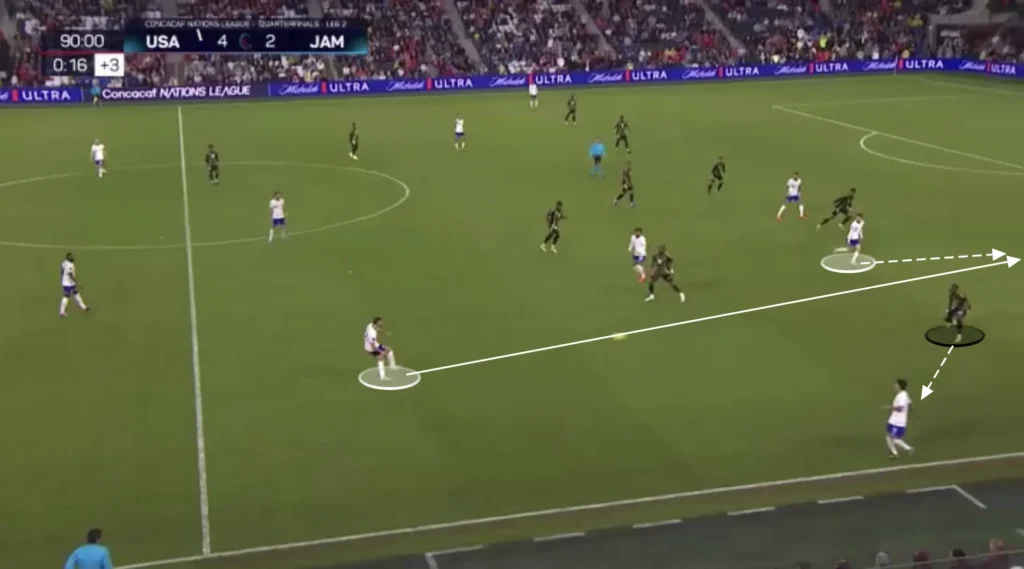
The USA attackers will use counter-movements like these all the time. When one attacker drops, the other will go in behind, constantly creating questions for the opposition defenders.
Attacking the Half-Space
In the final third, Pochettino’s players usually look to create chances by attacking the space between the opposition center-back and fullback. They primarily do this from the wide areas with underlaps from the attacking midfielders. When the USA winger receives the ball out wide, he will attract the opposition fullback. This opens the space between the opposition fullback and center-back, which allows the attacking midfielder to make the underlapping run into this space. The ball can be played to the underlapping player, who can cross the ball into the box or attack his defender in a 1v1 situation.


Additionally, the winger does not have to play the ball to the underlapping player. The run from the attacking midfielder will often drag away an opposition defensive midfielder, which opens the space inside. The winger can take the ball inside and shoot or find a pass to a free player in front of the backline.
USA will also exploit this gap between the opposition fullback and center-back with through-balls to well-timed runs from the midfielders. These incisive movements add an extra layer to the USA offense, making it harder for defenses to stay organized.

Counterattacks
USA’s counterattacks are a key element of their tactical approach under Mauricio Pochettino. The team is highly organized defensively, setting up with a compact, disciplined shape that allows them to quickly transition from defense to attack. Once they win the ball back, the USA players waste no time moving it forward with precision and urgency.
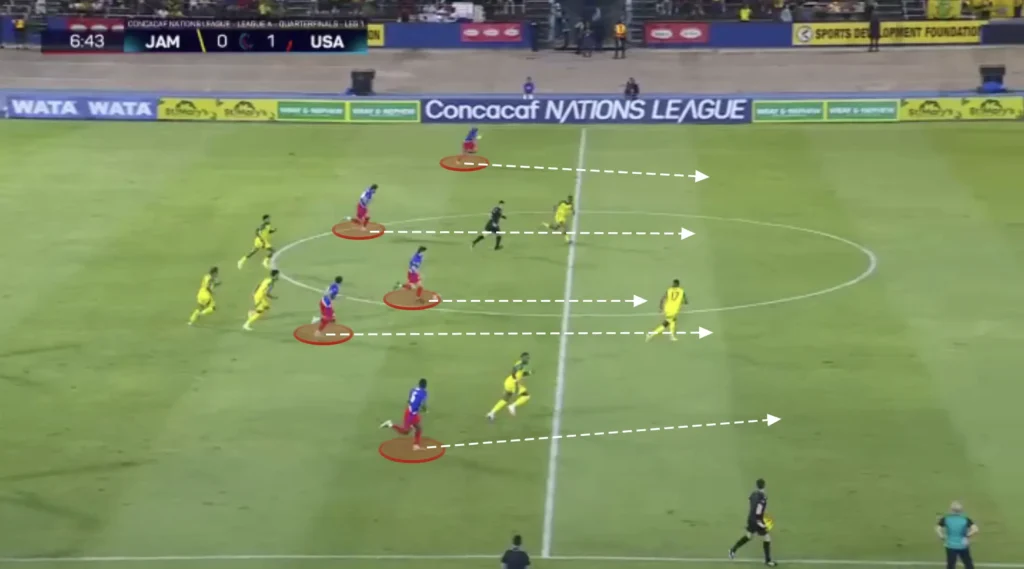
Midfielders play quick, vertical passes to exploit the spaces left by an advancing opposition, often aiming for wide players or strikers who position themselves to break into the attacking third.
Additionally, the USA players are great at finding open spaces in the counterattacks. Instead of playing the ball straight forward where opposition defenders may still be positioned, they play a diagonal pass, allowing the team to bypass pressure and shift the play into open areas.

From these areas, the USA attackers can take the ball forward and quickly get past the opposition to create a goalscoring opportunity.
Defending
USA’s base formation when defending is the 1-4-2-3-1 formation. They look to set up in a mid-block, always trying to close the center and force the opposition out wide.
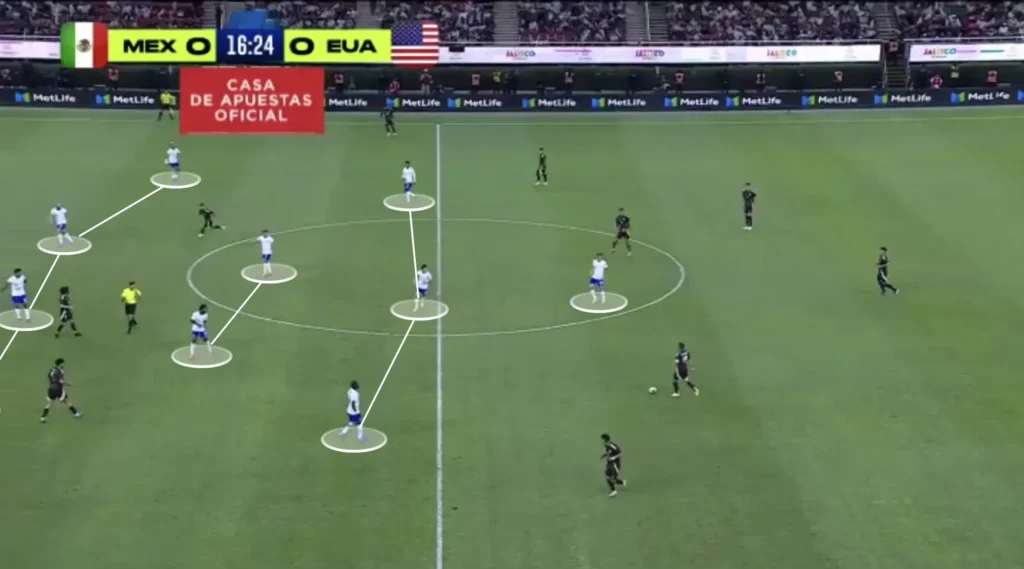
Defending in a 1-4-2-3-1 formation revolves around maintaining a compact and organized structure. The formation features a back four that provides stability, with two holding midfielders shielding the defense. These holding midfielders play a crucial role in breaking up opposition attacks and providing cover for the fullbacks when they break out of shape. The three attacking midfielders work to stop entries for the opposition and cut off passing lanes, while the lone striker applies pressure on the ball. The team aims to stay compact, forcing the opposition to play wide and limiting their ability to penetrate through the center. By maintaining this structure, the 1-4-2-3-1 formation helps to control the middle of the pitch, making it difficult for opponents to create scoring opportunities.
Pochettino’s defensive strategy is centered around regaining possession by steering the opposition to one side of the pitch. The striker initiates this by positioning himself to block central passing lanes, subtly nudging the ball carrier toward one flank. As this happens, a midfielder on that side follows closely, increasing pressure and cutting off easy outlets. This coordinated movement forces the opposition into a confined area where USA can overload with additional midfield or fullback support.


By limiting space and passing options, this tactic increases the likelihood of winning the ball in advantageous positions while disrupting the opponent’s build-up.
Pochettino is also known for his tactical flexibility when it comes to defensive formations. USA have, for example, used a 1-4-1-4-1 formation when defending in some games.

This versatility in their defensive approach allows USA to adapt to various opponents, giving them an edge in different match scenarios.
High Backline
One tool that helps to be compact is to play with a high backline, making the space to the midfield line as small as possible. Pochettino’s players do this and usually try to keep the highest line they can without leaving the space behind them too open. Defending with a high backline involves positioning the defensive line closer to the midfield rather than near the goalkeeper. This tactic compresses the space available for the opposing team to operate, disrupting their build-up play and increasing the chances of winning the ball back quickly.

A high backline also allows defenders to support the midfield more effectively, creating numerical superiority in central areas and facilitating quicker transitions from defense to attack. However, it requires defenders with good pace and positional awareness to deal with long balls and prevent opposing attackers from exploiting the space behind.
Additionally, everyone must be in the same line when defending with a high backline to maintain an effective offside trap, ensure cohesive coverage, and reduce gaps that attackers can exploit. A well-aligned defensive line makes it easier to catch opposing forwards offside, preventing them from receiving the ball in dangerous positions.
High Press
Pochettino often implements a high-pressing system designed to disrupt the opposition’s build-up and force turnovers in dangerous areas. Their pressing structure will depend on the opposition, but they primarily press in a 1-4-4-2 formation.
When the play starts, the strikers will try to close off one opposition center-back by making angled pressing runs, forcing the opposition to one side.

When the opposition plays the ball wide, USA’s press shifts into action. The ball-side winger and striker apply immediate pressure to the ball carrier, supported by the nearest central midfielder and fullback. This coordinated effort creates numerical superiority in wide areas, cutting off passing lanes and forcing rushed decisions. The far-side players stay compact and ready to anticipate switches of play or regain structure if the press is broken.

The USA winger will press from the inside, closing any passes into the middle. The ball-side striker will try to stop the opposition from switching sides by closing the pass to the ball-side center-back, while the USA midfielders, who have shifted across, will push up on the opposition midfielders. This gives the opposition fullback very few passing options and often triggers a rushed long ball, which the USA backline usually will win.
This aggressive pressing system targets the flanks, where teams are often more vulnerable under pressure. This maximizes USA’s chances of regaining possession and quickly transitioning into attack.
Final Thoughts
In conclusion, Mauricio Pochettino’s approach to coaching the United States national team reflects his adaptability and tactical ingenuity. By blending his high-energy philosophy with the unique attributes of the American squad, Pochettino creates a style of play that balances intensity, structure, and creativity. His emphasis on fluid formations, proactive transitions, and cohesive team dynamics has the potential to elevate the team’s performance on the international stage.
As Pochettino’s tactics continue to take shape, the United States looks poised to grow into a more competitive and confident force in world football. The journey ahead under his leadership promises to be both ambitious and exciting.
